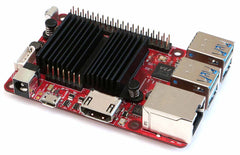
OS Releases: Lubuntu 20.04 with Panfrost Hardware Acceleration for the ODROID-C4
Share
 Melissas Miltiadis teased on Facebook of an upcoming release of Lubuntu 20.04 with Panfrost Hardware Acceleration for the ODROID-C4.
Melissas Miltiadis teased on Facebook of an upcoming release of Lubuntu 20.04 with Panfrost Hardware Acceleration for the ODROID-C4.
Install Lubuntu on ODROID-C4 with Panfrost drivers (hardware acceleration)!!! Kernel 5.9.6-meson64, Installation guide will follow shortly!
CASE OF PROOF!
He's followed through and come out with an installation guide to make it happen.
Here is his installation guide
- Download Armbian Focal (mainline kernel 5.9.y) from https://bit.ly/32Phh6v
- If you follow this guide apparently you know how to write the *.img on the microSD card or MMC... [Editor's note: If not, check out ameriDroid's How-To video: https://youtu.be/4f19Dm_CbvQ ]
- After first boot:
sudo apt updatesudo apt upgradesudo apt dist-upgradesudo apt install neofetchsudo apt install lubuntu-desktop- Now have a cup of coffee as it will take some time! After it is done:
sudo apt install mesa-utilssudo apt install glmark2- Now the nice part - install the Panfrost drivers (GPU)
sudo apt-get install software-properties-common -ysudo add-apt-repository ppa:oibaf/graphics-driverssudo apt-get updatesudo apt-get upgrade- Reboot and enjoy!




8 comments
@Zerael – See our newer blog post for an option that seems to be much more stable: https://ameridroid.com/blogs/ameriblogs/how-to-panfrost-ubuntu-20-10-linux-kernel-5-10-0-rc4-on-odroid-hc4
I ended up using a microSD Card and my results were sobering to say the least, I am afraid. After following the instructions to the letter and receiving no error messages, the resulting system will boot, but is unstable. After a few minutes it will inevitably crash with sudden and unrecoverable black screens.
The one time I had it working long enough that I actually managed to watch YouTube (using Firefox). It did play smoothly in FHD but with high CPU usage, so I don’t think that any HW acceleration was working. QHD and UHD were both slideshows.
Didn’t manage to keep the system running long enough to successfully install Chromium for a comparison…
Trying to play a x265 FHD mkv file over the network with VLC resulted in another complete system freeze. (Although audio was still playing…)
I’m afraid we’re not there yet and it’s back to Kodi (Coreelec) for me.
If anyone else is following this thread and has an Odroid-C4 they can use for testing that would be great, to make sure it’s not just me. However, my board is otherwise stable and has never given me any trouble when used with Coreelec.
@Bo
Thank you for the suggestions!
I didn’t know Balena Etcher could do that. Will give it a try and report back here, in case anyone else is interested in the results.
(This might take a few days though. My spare time and the time my family is using Kodi usually overlap… )
@Zarael – There are two ways you can try it out without nuking your Coreelec install or buying more eMMCs:
1. Do the reverse of imaging an eMMC – write your existing eMMC image to a .img file on your computer using balenaEtcher, Win32DiskImager, Linux’s dd command, etc. Reimage the eMMC with the new image you want to test. When done testing, reimage the eMMC with the .img file you created earlier and you’ll be back to where you were.
2. Use a microSD card for testing the new image (common and inexpensive, but slower and less reliable over the long run). Remove the eMMC from the ODROID-C4 and boot off the microSD.
@bo Thank you for clarifying!
Now, if only I had a way of trying it on my C4 without nuking my Coreelec install (or buying more eMMc)…